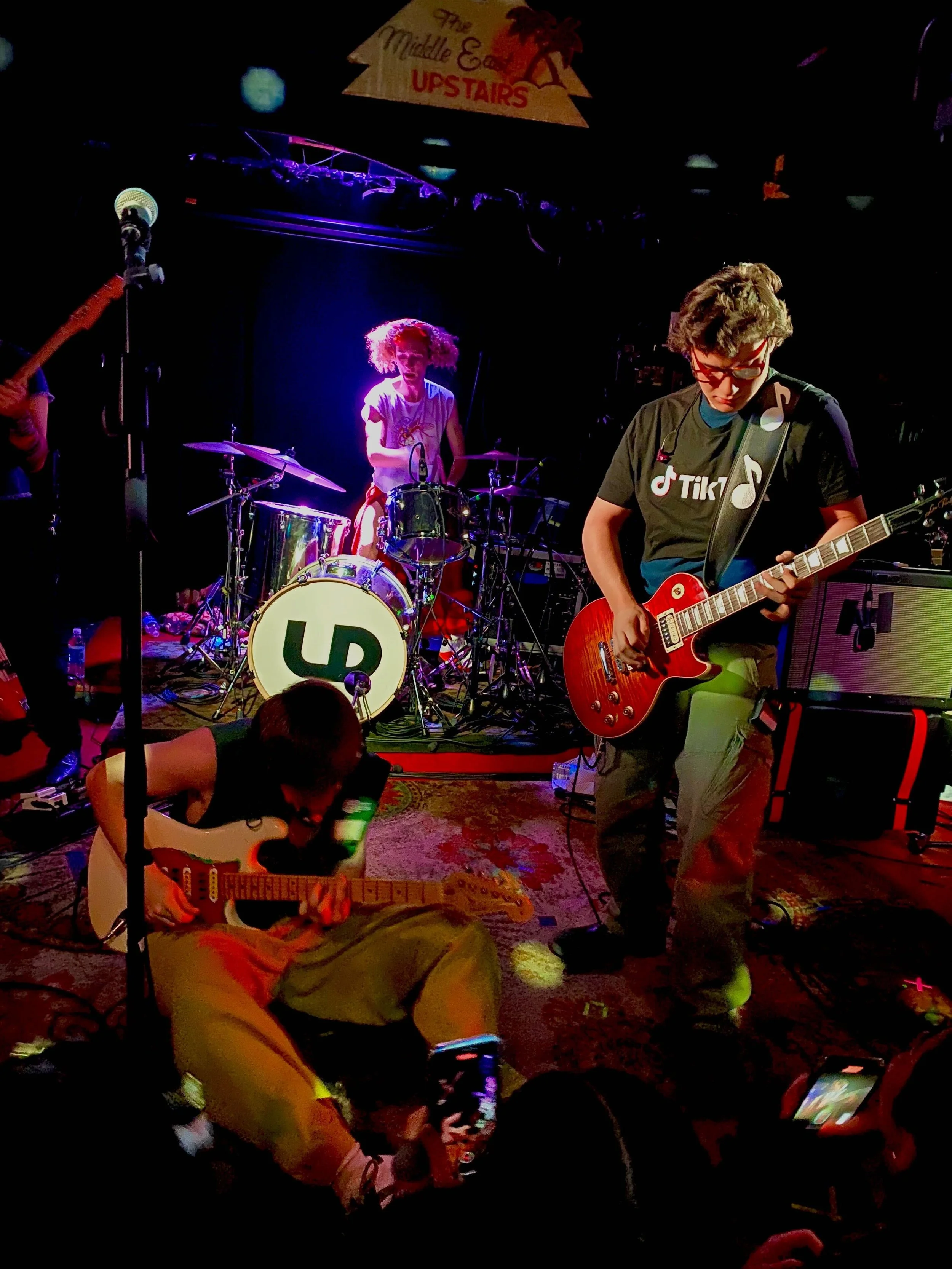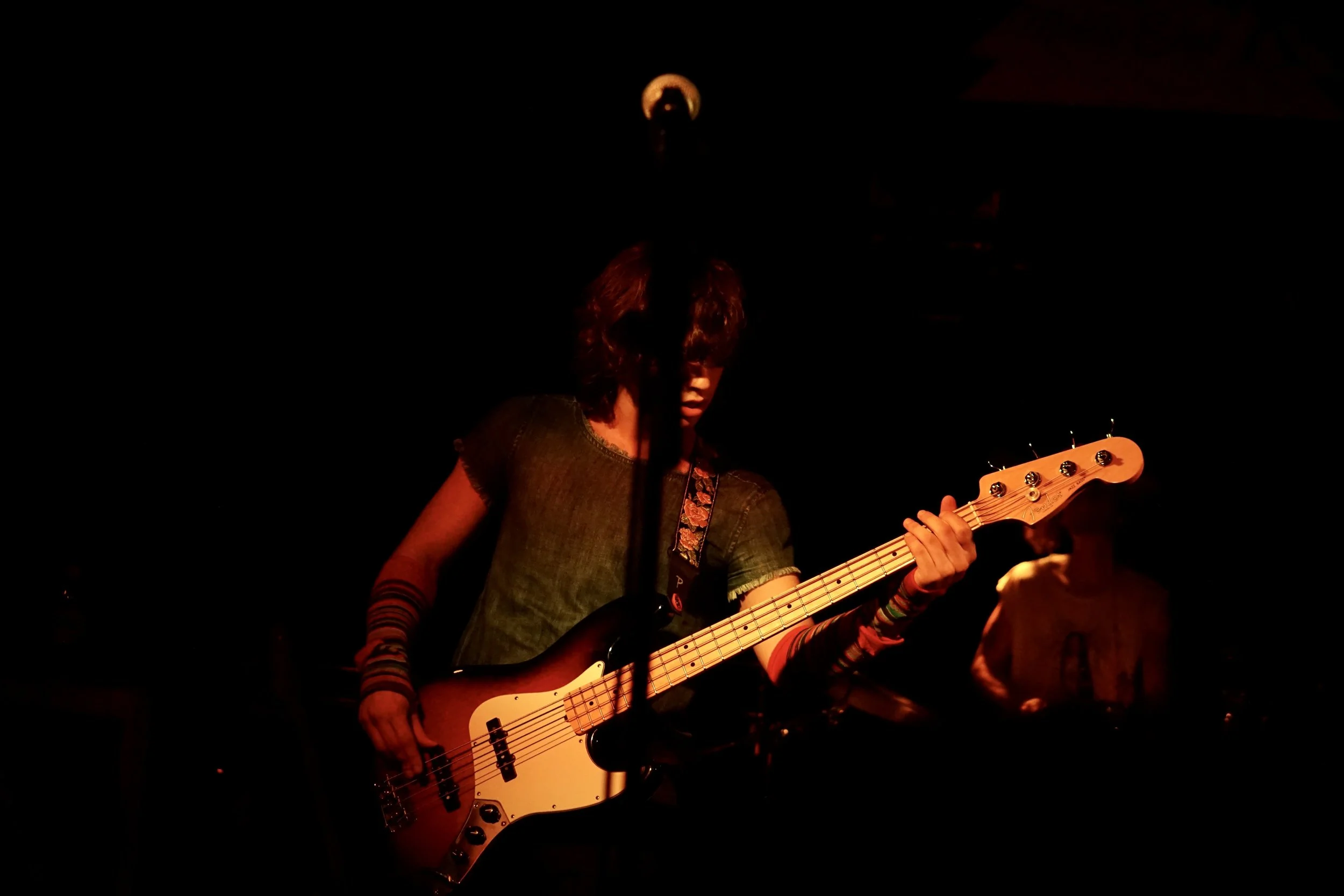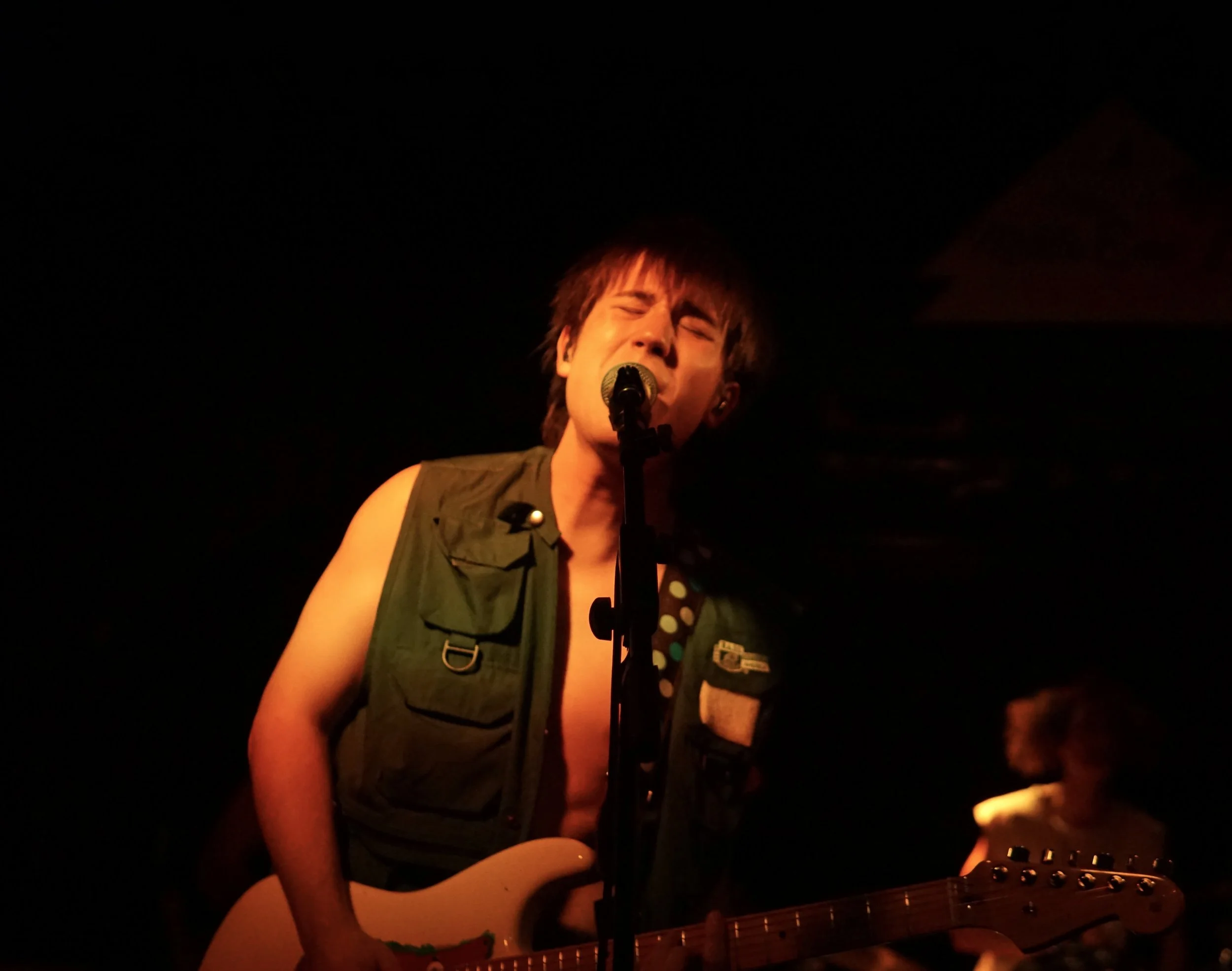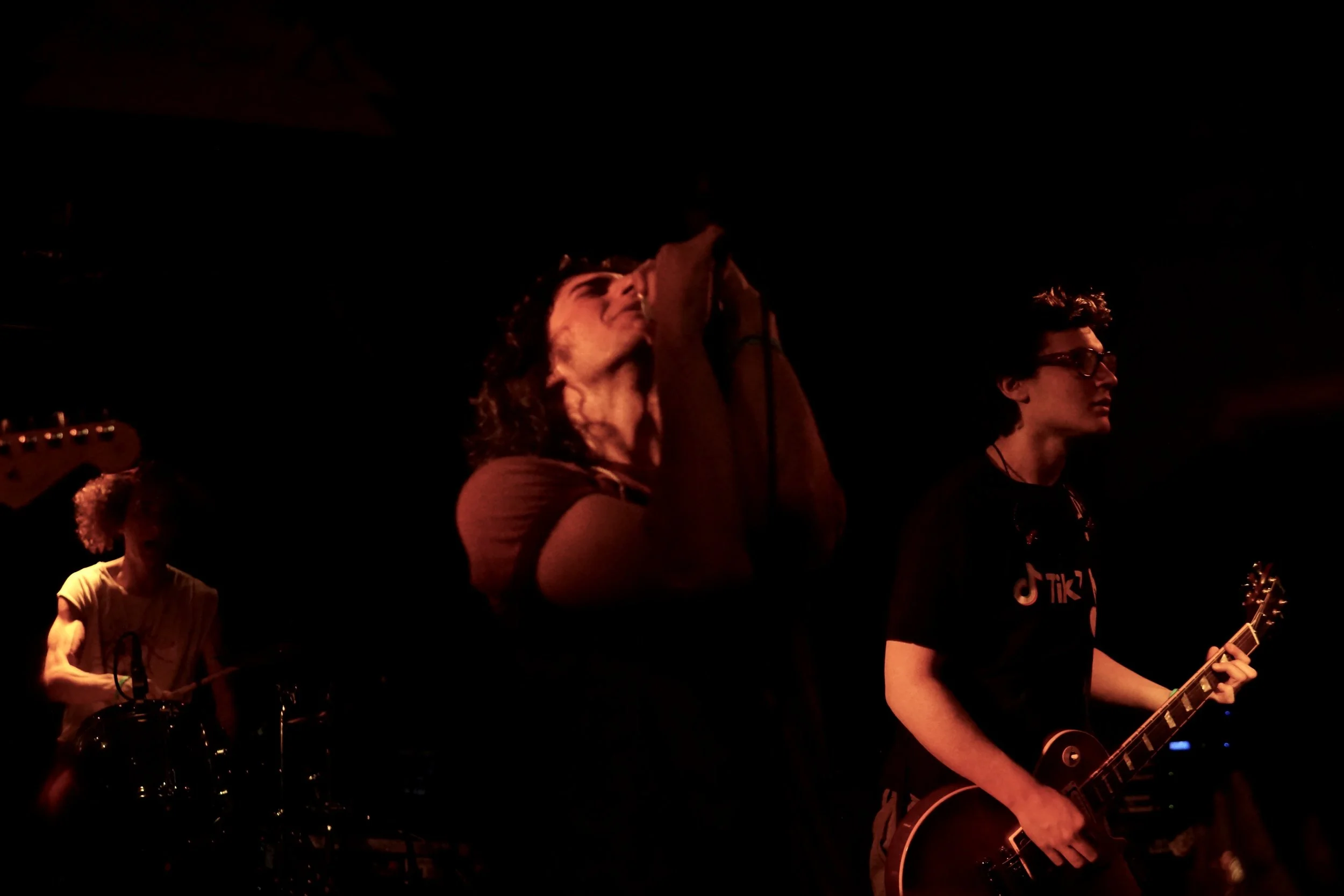LAUNDRY DAY on Gas Stations, Favorite Lyrics, and Where’s Waldo
It's 6 pm on a Friday in Central Square, Boston, and the members of LAUNDRY DAY are finishing up dinner at the Middle East Restaurant, their second to last pre-show meal on their U.S./Canada tour.
Since their formation in 2018, LAUNDRY DAY has remained a genre-defying force. The five piece band – consisting of vocalists Sawyer Nunes and Jude Ciulla, guitarist Henry Weingartner, drummer Etai Abramovich, and bassist Henry Pearl – met at high school in Hell’s Kitchen, Manhattan.
While LAUNDRY DAY are known to be comfortable performers of multiple genres, their music is clearly unified. They capture what it means to grow in understanding of who you are, to live with feelings of anxiety, to find your artistic voice– uniquely encapsulating the experiences of our generation.
It’s a rare kind of euphoria finding a band that so acutely articulates emotions and experiences you’ve shared, but never fully described. As the audience at their show later that night shouted LAUNDRY DAY’s lyrics back at them, it was clear how much their words resonated.
The release of LAUNDRY DAY’s third full length album, We Switched Bodies, marks a unique shift in their own distinct style not only in terms of music, but also the band’s fashion and visual art. “It's always been much bigger than the music to us,” Etai says. “Every opportunity that we do have to do something creative, we’re gonna do it to the best of our ability.”
Toward the beginning of the show, Jude asked the crowd if they had been to a LAUNDRY DAY show before – over half the audience raised their hands. “If this is your first show, welcome to the family.”
Stream LAUNDRY DAY’s newest album, We Switched Bodies!
This is your second to last stop on tour! How’s tour been?
JUDE: A lot of work and not so much sleep, but really fun. We were just saying being out on the road and meeting fans and playing music has just been so energizing. We’re very fired up to go home and make some new music.
What have been some of your favorite parts about touring besides performing?
SAWYER: I love when we’re halfway to a city– we always stop at a gas station. The people who are at the gas station have never once seen this many people in one group before, or even just the way we dress. Seeing people have no idea what they’re looking at is always fun. I don’t think we’ll ever look normal so we always just like to make a scene everywhere we go.
ETAI: Different vibes everywhere. It’s so fun to get a perfect little sample of each place. You see what cities you might want to go back to, which cities who definitely wouldn’t want to go back to. You see it all.
Part of what I (and know many others love) about your music is that it often switches genres. Is there a particular genre you associate with?
JUDE: I always say alternative is probably the best one word if we wanted to confine. But I think rock is also cool. I just feel like rock has a bad rep– or when you think of it, you think of such a specific thing. But I feel like when you zoom out a little bit and just look at the attitude around rock music, I think we identify with that a lot. In the live show, it comes out even more.
What do you miss most about New York when touring?
LD: The food probably.
ETAI: The variety of people and food and just establishments– there’s a little bit of every culture.
HENRY: My dogs.
SAWYER: After the shows – even in bigger cities sometimes – it seems like life is just over, like no one is even awake.
HENRY: We miss that about New York. It’s always moving.
JUDE: And that we know New York so well. Like there we probably could have found certain things at night that we didn’t. At any moment in New York we know where to be and where to go. And I miss that security.
HP: Maybe that’s why New Yorkers are always in a rush. We’re so used to having everything next to us fast.
Do you have favorite lyrics on the album/lines you wrote that really resonated with you?
JUDE: I think mine is “I’m so insecure. But wow, I love the way I look.” I relate to that a lot, so I was really proud I was able to capture that feeling.
SAWYER: I love “We Switched Bodies.” I just feel like it’s so simple and it's a great example of how you can come up with something and have your own associations with it. But once you release it, you can't control how people are gonna perceive it. That was one that the entire album process we knew would do well, or like people would like, but we thought of it as a joke and now it’s one of the more serious songs in our set.
HENRY: For the record, my favorite lyric on the album is “I’m like a dog.”
Can I ask what “Blübe” is about?
SAWYER: The whole album we were struggling with what our real truth was. Like, how do we kind of give our most genuine selves? That song is about getting caught up in looking and feeling cool. Being in a cool situation and realizing that sometimes when you make up a persona for yourself, then you're just putting yourself into a situation that isn't beneficial for you actually are. The idea that I had when I first came up with it was: if you're like a phoenix and you're swimming in the ocean, you’re doing yourself a disservice cause you’re just gonna burn out really fast. It was the kind of thing where you write something and you don't know what it means, and then you look back on it a couple months later and you're like, “oh, this kind of connects to this big thing that happened in my life that I didn’t even know how to express.”
JUDE: Yeah, and this goes for any piece of music where you don't really need to know what it's about for it to still be great. And that's why sometimes it is fun to be more abstract with it. But on the other hand, I know I definitely like to make [the message] really obvious, so that it's like “this is what the song is, and it can't just be like “a vibe.””
HENRY: For the record, my favorite lyric on the album is “I’m like a dog.”
If you could switch bodies with any musician past or present, who would it be?
ETAI: Lenny Kravitz.
JUDE: Michael Jackson. I just need to be Michael on stage just once. I just need to perform as Michael Jackson once. There’s videos where he just looks at someone and they just fuckin faint – I wanna just do that once.
HENRY: I’m going with Prince.
HP: I would wanna be Niel Peart, the drummer from Big Time Rush. I’ve always wanted to be able to play drums.
SAWYER: I think I’m going with Jay-Z. Just completely different roles.
JUDE: And then you’d get to be with Beyonce. That’s huge. I didn't even think about that factor.
SAWYER: And I’m with Beyonce? Yeah, I’d be Jay-Z as long as I can.
What were some of the inspirations for the art/music videos for the album?
JUDE: Where’s Waldo. There’s a lot of crowded spaces where you kinda don't know where to look, [and we] felt like that visually represented the music in a lot of ways. We originally envisioned [the album cover] looking even more Where’s Waldo-esque, [retaining] that idea where you [first] see it and think “what the fuck is happening?” and then you sort of figure it out. In the same way, if you listen to the songs on We Switched Bodies, [you also think] “what the fuck is happening?” and then figure it out. And the video is really just us running around – there’s a lot of fast movement and a lot of different people in the background. It has the same sort of “I don’t know where to look” effect.
ETAI: I would also say like New York street art was really big, [especially] hand drawn posters from the 70s psychedelic era. We tried to renounce digital art just for fun just to see how far we could take the idea of only things that were made tangibly. I think it ended up creating things that don’t really fit in the world of the art that bands are making to support their music.
JUDE: I’m really proud of the album cover and the posters. I just feel like because of technology, a lot of art is very, very simplified nowadays, and people's album covers are just so lame. We had had a few of those covers, so I wanted to make sure that we were all very adamant about [making] some really fucking dope art.
ETAI: Also, it’s always been much bigger than the music for us. Every opportunity that we do have to do something creative, we do it to the best of our ability. It goes beyond tour posters and videos, [such as when] we’re on stage. How we actually conduct ourselves on stage in between songs, there’s always an opportunity for some choice… A lot of artists I think don’t realize they have the opportunity to do that kind of thing.
SAWYER: I think we've gotten really good at knowing what we want and then realizing that maybe in the moment, we don't have the exact skills to execute it. And in the case of the album cover we found the best artist – and we’d been talking about something like that forever – it’s just the most satisfying feeling.
JUDE: There was someone specifically that met me after a show and she was like, “I got an ad with the tour poster on Instagram, and I loved the post, and wanted to know more.” That's so fucking cool! Similarly, someone [once] said to me, “I saw the album cover and I had to listen.” Those two experiences – that's all we wanna do. And think about how many things just pass you by online and how crowded it is – to have art that takes things to the next level and goes above and beyond, that finds people in a stronger way, is so cool.
SAWYER: We’ve had periods where we’ve found both musically and visually that it gets easy to fall into niches of things we’d already done. [It] just takes time to find something that makes sense. The posters are so unique and so beautiful, and Etai drew them all! We know we’ve made something that no one can really recreate in that way and that’s something we want to continue [doing]. No matter what your opinion, you can say that it’s just never been done before. I think we had a period where we were doing things that had never been done before that wasn’t necessarily good. Then we were like ok– we have to do this, but also balance the line of being unique and true to yourself with wanting people to relate to your stuff.
ETAI: I think what differentiates something that’s just totally brash and experimental from something that’s new and inventive is having an entry point for people to grasp onto it in some way. You do that by blending something that’s never been seen before with something that’s familiar to them. It can be the posters that you draw, or the lyrics that you write, etc, but it’s important to be inviting to people rather than alienating them when you’re doing stuff like that. I think that’s what we realized most of all [in the process of recording this] album. We want arenas to be yelling songs back to us, so we have to keep that in mind when we’re creating.
SAWYER: Right, and we try to manifest that everywhere. That has always been the thing, even when we were playing our high school lunch time first show. We thought of it so seriously. We’ve never wanted to give our baby away to anybody, and so as long as that energy stays there, I think we’re in good hands because they’re our hands. It's so amazing that we get this experience – we’re not taking anything for granted, and taking control of the art because we have the opportunity to live up to our fullest potential.
This interview has been edited for length and clarity.




